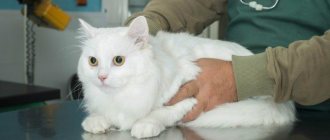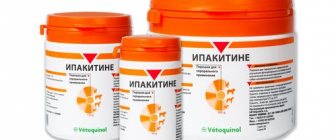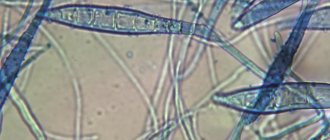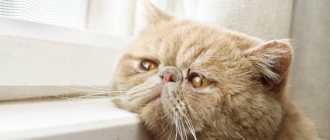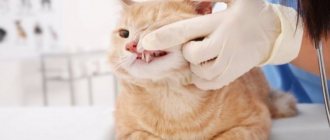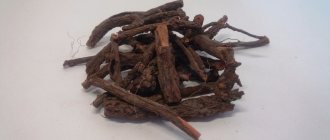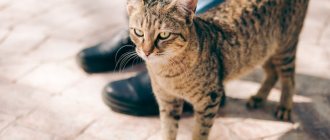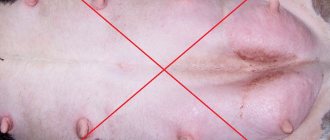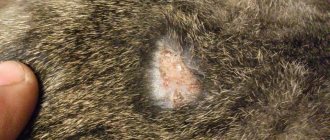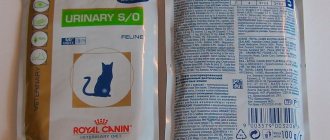The author of the article is Kira Vadimovna Chernaya, a veterinary therapist at the IVC MBA.
Calcium oxalate (OxCa) is a salt of the alkaline earth metal calcium and the organic dibasic oxalic acid. Stones of this type are quite sharp, polygonal, due to which they strongly scratch the wall of the bladder, renal pelvis, ureters and urethra, causing pain and causing great damage to the mucous membrane. The detection of crystals of these stones in a urine test indicates a disturbance in the metabolism of oxalic acid salts and severe acidification of the urine. The formation of calcium oxalates often occurs in stressful situations, when the body does not have enough fluid for normal urinary function of the kidneys, with a weakly acidic urine reaction.
Cats with urolithiasis (presence of stones in the bladder) experience classic symptoms of feline cystitis: strained urination (sometimes even with vocalization due to pain), blood in the urine, diuresis (urination) in inappropriate places, licking of the genitals, frequent sitting down. Very often, cats pee on their owners' beds because they consider this place to be the safest in the world and try to help themselves in this way. In severe cases, usually in males, acute urinary retention occurs. Symptoms may be complex or absent altogether until a certain point. Usually, owners go to the veterinary clinic when the cat often sits on the tray for a long time, trying to pee, but 2-3 drops come out, sometimes with blood. The animal may scream, and sometimes there are puddles in different parts of the apartment.
Cats with nephrolithiasis (the presence of stones in the renal pelvis) and ureterolithiasis (the presence of stones in the ureters) may have no clinical signs of the disease at all, since cats rarely show chronic pain. Sometimes owners come to the clinic with complaints of apathy, lethargy, pain in the lumbar region of their pet, sometimes the cat may refuse to eat and vocalize.
Causes of ICD
There are many factors that contribute to the development of urolithiasis. All reasons are conventionally divided into external and internal. In this case, a combination of several provoking conditions is possible.
Exogenous
External causes are related to the living conditions, activity, and nutrition of the cat. One of the first places is irrational nutrition. An imbalance of proteins, fats, and carbohydrates leads to a shift in urine pH to the acidic or alkaline side. In both cases, solid conglomerates begin to form in the urinary organs. Vitamin deficiencies are also related to diet. All biologically active substances are important, but this is most true for vitamins A and D. Vitamin deficiency leads to metabolic disorders.
Thirdly, the lack of water and/or the high saturation of the liquid with minerals affects it. This factor affects the concentration of urine. In a more saturated liquid, solid inclusions form faster. The need for water increases if the cat lives in hot home conditions.
For some scrupulous cats, the cleanliness of the tray is important. Dirty litter makes the animal endure. Retention of urination provokes and accelerates stone-forming processes in the urine. In this case, signs of the disease appear faster.
Urolithiasis in cats is most often recorded at the very beginning of autumn, as well as in January-April.
Endogenous
Hormonal disorders can lead to the development of urolithiasis in cats. Internal causes also include diseases of the digestive system. If the food contains enough nutritional and biologically active compounds, but the cat has intestinal problems, the valuable substances will be poorly absorbed by the body. It is endogenous reasons that explain why cats of one breed or another are prone to urolithiasis. A set of genes, changes in their activity or structure influence the occurrence and rate of progression of urolithiasis in cats.
Diagnostics
Correct diagnosis in veterinary practice for kidney disease in a pet is impossible without laboratory testing of urine.
Kidney diseases in cats and their consequences for the animal.
Kidney diseases in cats and their consequences for the animal.
Kidney diseases in cats and their consequences for the animal.
Kidney diseases in cats and their consequences for the animal.
When studying the urine of a sick animal, its pH, density, presence of casts, sediment, leukocytes, erythrocytes and pathogenic microflora are determined.
Symptoms of urolithiasis in cats
global $ads_google; //data-ad-slot=”2475549904″ $ads_google = empty($ads_google) ? false : true; ?> if ($ads_google == false) {?>
$ads_google = true; ?> } ?>
Problems with the lower part of the excretory system manifest themselves in behavioral signs at the earliest stages. The cat becomes apathetic and its appetite may change. The more the disease progresses, the more obvious the symptoms appear. In this regard, three symptomatic periods are distinguished: early, acute and critical. At the first stage, when sand and stones are already present in the bladder, urolithiasis in cats can be judged by the following signs:
- The pet goes to the toilet more often, and sometimes in the wrong places.
- Urination occurs in a tense position.
- While in the litter box, the cat meows from the pain caused by the stones.
- The presence of blood cells causes the urine to turn pink.
- The cat takes longer than usual to lick itself under its tail.
During the severe (acute) stage, these symptoms become even more obvious and others join them. The animal has urinary incontinence in a small volume, and the color of the liquid itself becomes more saturated. Urine acquires a specific unpleasant odor. Touching the belly causes pain in the cat. Body temperature jumps to 39-40 degrees.
In critical condition, the signs of urolithiasis worsen even more. The pet practically does not go to the toilet, and the urge causes severe attacks of pain. An overfilled bladder can lead to rupture and peritonitis. Viscous, foamy saliva is released from the mouth, and vomiting is possible. The temperature drops to 35-36 degrees. Body tremors and convulsions are added to apathy and lethargy. In the most severe cases, loss of consciousness is possible.
Causes of struvite in cats
Phosphorus salts participate in the formation of struvite or phosphate. Struvite stones are usually shaped like a circle, oval or tetrahedron. Mainly localized in the bladder.
The main predisposing factors for the formation of stones:
- Feeding. A diet that is dominated by foods high in magnesium and low in protein and fat promotes the formation of uroliths. Supplements that alkalinize urine, low calorie feed and low moisture content increase the risk of disease.
- Infectious diseases . Struvite caused by infection is rare and is more common in kittens (under 1 year of age) and older animals (over 10 years of age).
- Age, gender, breed. Cat breeds with long hair such as Persian, Himalayan, Oriental, Ragdoll are predisposed to urolithiasis. And vice versa, in Russian Blue, Siamese, Abyssinian, Burmese cats, struvite-type urolithiasis is much less common.
- Lifestyle. At risk are animals with extra pounds, castrati, leading a sedentary lifestyle, and consuming little fluid. It has been noted that cats with constant access to the street are less likely to suffer from ICD.
According to average indicators, struvite in the urine of a cat is formed at the age of 2-6 years.
Conditions of occurrence
For struvite to form, three conditions must be met:
- The main reason is the high level of concentration in the urine of the components that make up the stones (magnesium, phosphate, ammonium). The higher the level, the faster the formation of urolith.
- Struvite in urine is formed if there is a base (core) around which sand and crystals accumulate. According to a number of observations, desquamated epithelial cells, bacteria, and suture threads (in the case of a previous operation) can serve as such a basis.
- Acidity of urine. Struvite often forms in an alkaline environment (pH level greater than 7). The risk of stone formation is reduced at a pH less than 6.4. This acidity promotes the dissolution of existing stones. However, crystals or stones are also found in a neutral environment. Therefore, bringing urine to a neutral or acidic level cannot be the only remedy that can cure urolithiasis.
The process of formation of uroliths in ICD, if it begins, proceeds very quickly. Otherwise, the crystals would be washed away by urine and would not have time to turn into stones.
Treatment of urolithiasis at home
If you notice signs of urolithiasis in your cat, you should immediately contact the veterinary clinic. But you can use some home remedies to alleviate the symptoms. They help make the suffering animal feel better. A warm heating pad is placed on the stomach. After visiting the veterinary clinic, the owner’s duties include careful care of the animal. He is provided with only home conditions; walks are temporarily canceled. Great importance is attached to food, purified water, a clean tray, and compliance with the schedule for taking medications prescribed for treatment.
If you have urolithiasis, you should not massage your stomach in an attempt to relieve pain or speed up the progression of stones!
Treatment for urolithiasis
Drugs
The removal of small stones is facilitated by relieving muscle spasms using No-shpa.
If a Briton is diagnosed with urolithiasis, it is not advanced, and there are no blood inclusions in the cat’s urine, the pathology can be treated conservatively, using medications prescribed by a veterinarian. In order for the stone to dissolve and come out, the following groups of drugs are prescribed for struvite and oxalate:
- Antispasmodics. If an animal has renal colic and muscle spasms, the following drugs are used: “No-Shpa”;
- "Baralgin";
- "Spazmolitin".
- "Travmatin";
- "Stop cystitis";
In order to prevent complications, the pet is given Furadonin.
Antibiotics for cats with urolithiasis are prescribed as the inflammatory process progresses. The following remedies will help prevent the development of complications:
- "Sinulox";
- "Nitroxoline";
- "Furadonin".
When the acute symptoms disappear, you can prepare an anti-inflammatory and diuretic decoction of nettle, bearberry, chamomile, birch leaves and buds at home. To prevent urolithiasis at home, it is recommended to treat with dead water. If the stones are small and soluble, the healing liquid will help get rid of them and remove them from the body naturally.
When is surgery necessary?
With the progression of urolithiasis in sterilized cats, conservative methods are powerless. Stone removal is carried out according to the following indications:
- large size of stones;
- presence of calcium oxalates;
- complete blockage of the urinary ducts.
Sometimes stones can be removed by opening the bladder.
The following surgical techniques are used:
- Urethrotomy. A hole is formed in the affected duct through which the stones are removed.
- Cystotomy. It is prescribed in severe cases when other methods are powerless. During the operation, the bladder is opened and stones are removed.
Laser crushing of stones - lithotripsy - is also often practiced. It is advisable to do this procedure if the size of the pebble is small. After the operation, the particles are eliminated from the body naturally. To prevent complications, postoperative drug therapy is prescribed using antibiotics, anti-inflammatory drugs, and vitamin and mineral complexes.
Dietary recommendations
With urolithiasis, the animal must be treated comprehensively and, in addition to the use of medications, it is important to follow a therapeutic diet. Otherwise, a cat with such a diagnosis will not be able to live long, since urolithiasis will progress, often recur, and the animal will have to be euthanized. To prevent such complications, it is recommended to follow the following nutritional rules:
Eggs should be removed from your pet’s diet if his body is prone to struvite deposits.
- Strictly follow the regimen prescribed by the veterinarian.
- If struvite is found in the urinary organs, calcium, dairy products, and eggs are removed from the diet. The animal should be given acidified water.
- If oxalates are detected, acidic foods, offal and foods rich in calcium are excluded.
What to feed a cat with ICD
When treating a cat for urolithiasis, be sure to use special food for cats with urolithiasis. They have a balanced composition of nutrients, minerals and vitamins. The type of cat food is chosen depending on what stones have formed in the genitourinary system. Natural nutrition is selected individually, but in any case it is recommended to avoid seafood and dairy, as they are saturated with mineral salts.
Diet for oxalate stones
Food should contain a minimum of oxalic acid. If the pet is on homemade food, then offal (liver, kidneys), as well as dairy dishes containing a lot of calcium, should be temporarily excluded. The therapeutic diet includes meat, vegetable stew made from cauliflower, carrots, beets and pumpkin, and rice porridge. If you buy ready-made food for your cat, you need to carefully choose the variety. For oxalate stones, the following is suitable for a cat:
- Hill's Prescription Diet Feline K/D or X/D
- Royal Canin URINARY
- Eukanuba Oxalate Urinary Formula
Hill's Prescription Diet Feline X/D. It has a reduced concentration of calcium and phosphorus, but an increased amount of potassium citrate and soluble fiber. This dietary food should not be fed to pregnant cats, young kittens or cats with struvite crystallization. Hill's Prescription Diet Feline brand K/D is used for stones of any nature.
Royal Canin URINARY is used for both therapeutic and preventive nutrition. It increases urine output and inhibits the formation of stones. The food has limitations - high blood pressure and abnormalities in kidney function.
Eukanuba Oxalate Urinary Formula is a low-calorie dietary food with reduced calcium and fat content. Ingredients are chicken, turkey, egg, cornmeal. Wet food comes with fish. Contraindications include pregnancy, lactation, and under one year of age.
Diet for struvite
Phosphate stones, which form in an alkaline environment, require a change in pH to the acidic side. This is partly facilitated by medicinal food or a properly selected diet of natural products. The cat should not be fed dairy products (cottage cheese, cheese, milk), or egg yolks. It is recommended to prepare dishes from oatmeal, rice, liver, egg whites, lean beef and veal. An alternative could be:
- Hill's Prescription Diet Feline S/D, C/D
- Eukanuba Struvite Urinary Formula
Hill's Prescription Diet Feline S/D is a medicinal food that fully meets the nutritional requirements of this category of cats. The composition contains meat, chicken fat, rice, corn flour, starch. This food should not be offered to small kittens under one year old or pregnant cats.
Eukanuba Struvite Urinary Formula. It is used for struvite crystallization and tendency to fullness. Dry granules are made from corn grits, chicken, turkey, animal fat, and dried eggs. This variety is not given to pregnant and lactating females and small kittens.
Why do these stones appear? What else do we know about them?
- Twenty-five years ago, calcium oxalates were not found in cats, most often stones of the struvite type (a matrix of ammonium-magnesiophosphates) were detected.
- The veterinary food industry produced food to maintain the urological health of cats, acidifying the products to prevent the occurrence of struvite urolithiasis. In general, it worked - the number of cats with diseases of the lower urinary system decreased significantly. The trade-off was that under the influence of an acidic environment, calcium oxalates began to form, since at this pH (acid-base environment) calcium loss increased. Currently, the majority of kidney and ureteral stones in cats are calcium oxalates.
- Burmese and Himalayan cats are genetically predisposed to this type of urolithiasis.
- Most often, this disease occurs between the ages of 5 and 14 years.
- 35% of cats with calcium oxalate bladder stones have elevated calcium levels in the blood (hypercalcemia). It is advisable to examine the level of ionized calcium in the blood rather than the total level, as the result will be more accurate and indicative.
- In urine analysis, crystals of struvite (triple phosphates) are more often detected than oxalates, this is due to the strong structure of the latter.
- Cats with this pathology rarely have concomitant infections of the urinary system, and most often the urine density is high, that is, the urine is poorly diluted.
- Each animal has its own individual reaction to various substances, and even to suture material. If a surgical operation was performed to remove bladder stones, tumors, etc., and for some reason inflammation occurred along the suture, accumulations of calcium oxalate crystals may begin to form at this site, leading, in the future, to oxalate-type urolithiasis. Unfortunately, it is impossible to predict such a complication one hundred percent, which is why it is recommended to periodically conduct ultrasound, x-rays and monitor a general urine test for the occurrence of such problems.
- Urolithiasis of the oxalate type can occur due to metabolic acidosis (due to other problems, for example, diabetes, shock, trauma, ethylene glycol poisoning), systemically leading to active oxidative processes.
Prevention of urolithiasis
After the cat’s treatment is completed, it is necessary to adhere to the rules of prevention for the rest of its life. It also doesn’t hurt to remember these measures if your pet is prone to urolithiasis. Prevention consists of proper selection of dietary food, drinking regimen, medications and folk remedies.
global $ads_google; //data-ad-slot=”2475549904″ $ads_google = empty($ads_google) ? false : true; ?> if ($ads_google == false) {?>
$ads_google = true; ?> } ?>
Food for the prevention of urolithiasis
The cat's nutrition should be organized taking into account the nature of the stones. Your cat should be fed premium ready-made food. The varieties that were used in treatment are also suitable for prevention. The same goes for a natural diet. Products that, during metabolism, acidify or, conversely, alkalize urine, are excluded from the diet. In any case, the cat's menu should not contain strong meat broths, sausages, fatty and salty foods. Food should be varied and nutritious.
Your pet should always have fresh water of low mineralization.
Medications
Many medications that are used to treat urolithiasis are also used for prevention. For this purpose, it is advisable to select products with natural composition. The best option is to consult a doctor. Preventive veterinary medications for urolithiasis include Kotervin, Urinari tract support, Furinite, Cantharis composite.
Kotervin removes salts, promotes better urine flow, relieves inflammation, dissolves stones (with the exception of oxalates). It contains only natural ingredients: extracts of horsetail, steelhead, knotweed and bird's eye.
Urinari tract support is a complex veterinary preparation based on bearberry, phylanthus, cranberry, marshmallow, dandelion, and corn silk. In addition to the salt-removing, diuretic and anti-inflammatory effects, Urinari has a mild immunomodulatory effect.
Folk remedies
The collection of traditional medicine offers many recipes that help improve the health of a cat that has had or is prone to urolithiasis. They are not potent drugs, but provide preventive support.
In the morning on an empty stomach, it is recommended to give the cat strawberry or carrot juice (1 teaspoon each). An infusion of lavender, birch, currant, hops, chamomile, plantain, horsetail and rosehip is also useful for oral administration. Herbs and fruits are taken in 5 grams each, then 5 grams of the collection is poured into 500 ml of boiling water. The pet is given 10 ml 2-3 times a day for a month.
When bathing, you can use a herbal bath, which is prepared from a collection of herbs (chamomile, dried grass, birch, oregano, sage, linden). For 500 ml of boiling water, take 1 gram of each type of plant material. The infusion is poured into a basin where the cat will bathe.
Forecasts and methods of preventing urolithiasis
If a British, Persian, Himalayan or Scottish cat is sick with ICD and has all the symptoms, you should not delay visiting the doctor. Veterinarians warn that if treatment is untimely, cats with urolithiasis do not live long; due to complications, the animals fall into a coma and die within 2-3 days. When therapy is prescribed on time, the owner strictly monitors the pet’s diet and weight, and also carries out preventive treatment, the prognosis for successful recovery is favorable.
As a preventive measure for urolithiasis, animals at risk are recommended to undergo a urine test every six months. To monitor the condition of the house, you can purchase a special filler indicator, which will change color in case of any deviations. In addition, you need to monitor nutrition and drinking regime, take your pet out for walks more often, breathe fresh air, and buy special food designed to prevent urolithiasis. If there are characteristic signs, do not give medications at your own discretion, but go to the doctor, otherwise complications cannot be avoided.
Why is kidney failure dangerous for cats?
Kidney failure in cats requires treatment as soon as possible. And these are not empty threats. Every day the urinary system will work worse, and more toxic substances will accumulate in the body. They are not excreted; they poison internal organs and blood. Also, the kidneys stop coping with such tasks as:
- control of sodium intake into the blood (important for lowering and increasing blood pressure);
- regulation of fluid in muscle tissue;
- production of vital hormones;
- removal of toxins after drug treatment.
Genitourinary system of cats
There are cases when a pet fades away in a few days, and such consequences are real in both acute and chronic renal failure. Another problem is misdiagnosis. Signs of the disease often overlap with symptoms of other ailments, so the doctor’s experience is important here.
Slags
Many household items can damage your kidneys, not just antifreeze. Petals, leaves and pollen from lilies, even water in their vase, can cause serious kidney injury when cats nibble, lick or chew the flowers or come into contact with water. This is one type of flower that you should avoid completely if you have a cat! Common OTC medications such as aspirin, other nonsteroidal drugs (NSAIDs), or prescription drugs can all cause kidney disease. Cats, who are known for being picky about food and just about everything else, will still eat pills they find in your medicine cabinet or on the floor, so keep all medications in cat-proof containers. And always discuss the use of any medications with your veterinarian.
If you have any reason to believe that your cat has been poisoned, call your veterinary emergency number immediately for help. Contact us at the following numbers:
8-495-221-81-90
8-495-221-84-70
8-499-136-19-18
Other predisposing factors
However, the power characteristics may have nothing to do with it at all. Recently, many veterinarians believe that the main causes of urolithiasis are bacteria that secrete an enzyme called urease . It decomposes urine into its constituent components, as a result of which salts and other components may begin to precipitate. In addition, bacterial infections of the genitourinary system cause “scraping” of the epithelium from the walls of the genitourinary system. It, together with mineral components, can form an organic “matrix” of stones, on which salts and their crystals will subsequently grow.
Renal obstruction (ureteral obstruction with hydronephrosis)
Kidney stones can fragment and travel through urine into the ureter, the long, narrow tube that connects each kidney to the bladder. They are likely to cause severe pain as they move, and significant difficulty in functioning results in the kidney if they become lodged in the ureter, causing partial or complete blockage. New urine cannot pass out of the kidney easily and it recedes, causing the kidneys to swell. If there is enough pressure, the kidneys become enlarged (hydronephrosis) and damaged. If both ureters become blocked at the same time, this can lead to catastrophic consequences, including death.
Protein metabolism disorder (amyloidosis)
Patients with amyloidosis lose function of certain organs, including the kidneys, as protein deposits replace normal tissue. It is an unusual consequence of chronic inflammation affecting other parts of the body, or it may be genetic in some breeds such as the Abyssinian, Siamese or Oriental Shorthair. Amyloid deposits cannot be removed, and functional kidney tissue that is lost cannot be replaced, so the prognosis is not good.
Prevention of kidney diseases
General preventive measures:
- Proper care and comfortable maintenance of your pet.
- Avoiding hypothermia of the animal.
- Providing a balanced diet for your cat.
- Preventing falls from heights.
- Preventing the animal from walking on its own.
- Vaccination according to the vaccination schedule.
- Compliance with drinking regime.
- Water quality control.
- Organization of proper nutrition.
- Regular preventive examinations with a veterinarian.
Read also
Cystitis in a cat. Symptoms and treatment
Cystitis is an inflammation of the bladder. It is a disease of the genitourinary system that occurs not only in humans, but also in animals.
Castration of cats: pros and cons
Castration is the removal of the male gonads (testes in males, ovaries or ovaries and uterus in females)
Washing a cat: how to properly bathe an animal?
Many people know that bathing a cat can be difficult due to the animal’s excessive aggressiveness. Tabby pets have an innate fear of water, so when bathing
Worms in cats: symptoms, signs and treatment
The first signs of infection may be absent for some time or resemble manifestations of other diseases
Sterilizing a cat: at home or in the clinic?
Sterilization is an intervention as a result of which an animal (a cat in particular) loses its ability to reproduce
Varieties
Nephritis in cats is classified primarily by the speed of its progression. In this regard, a distinction is made between acute and chronic forms of the disease. According to localization, this disease can be focal or diffuse. According to the degree of tissue damage, they are distinguished:
- glomerulonephritis, in which the kidney glomeruli begin to deteriorate and gradually die;
- pyelonephritis – stage of purulent inflammation of the renal pelvis;
- interstitial nephritis, in which the tubules become inflamed and urine infiltration occurs.
The latter type of pathology in cats is quite rare. Against the background of glomerulonephritis, an animal, among other things, may develop a lipoid form of the disease, accompanied by the replacement of kidney tissue with fatty structures and their degeneration. This pathological process is very severe and is considered incurable.

